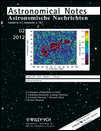The color-magnitude diagram of NGC 2264
Abstract
Existing photometry for NGC 2264 tied to the Johnson & Morgan (1953) UBV system is reexamined and, in the case of the original observations by Walker (1956), reanalyzed in order to generate a homogeneous data set for cluster stars. Color terms and a Balmer discontinuity effect in Walker's observations were detected and corrected, and the homogenized data were used in a new assessment of the cluster reddening, distance, and age. Average values of EB – V = 0.075 ± 0.003 s.e. and V0 –MV = 9.45 ± 0.03 s.e. (d = 777 ± 12 pc) are obtained, in conjunction with an inferred cluster age of ∼5.5 × 106 yr from pre-main-sequence members and the location of the evolved, luminous, O7 V((f)) dwarf S Mon relative to the ZAMS. The cluster main sequence also contains gaps that may have a dynamical origin. The dust responsible for the initial reddening towards NGC 2264 is no more than 465 pc distant, and there are numerous, reddened and unreddened, late-type stars along the line of sight that are difficult to separate from cluster members by standard techniques, except for a small subset of stars on the far side of the cluster embedded in its gas and dust and background B-type ZAMS members of Mon OB2. A compilation of likely NGC 2264 members is presented. Only 3 of the 4 stars recently examined by asteroseismology appear to be likely cluster members. NGC 2264 is also noted to be a double cluster, which has not been mentioned previously in the literature (© 2011 WILEY-VCH Verlag GmbH & Co. KGaA, Weinheim)




